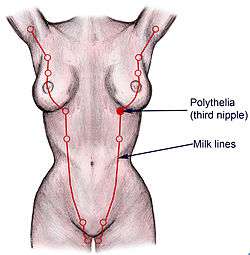Mammary ridge
The mammary ridge or mammary crest, is a primordium[1] specific for the development of the mammary gland.
| Mammary crest | |
|---|---|
 Natural milk lines in the human body | |
| Details | |
| Identifiers | |
| Latin | crista mammaria |
| Anatomical terminology | |
Development
The mammary ridge is primordial for the mammary gland on the breast in humans, and is associated with mammary gland and breast development.
In human embryogenesis the mammary ridge usually appears as a narrow, microscopic ectodermal thickening during the first seven weeks of pregnancy and grows caudally as a narrow, linear ridge.[1] In many mammals, these glands first appear as elevated ridges along the milk lines, which then separate into individual buds located in regions lateral to the ventral midline. The location of these buds varies according to species: they are located in the thoracic region in primates, in the inguinal area in ungulates, and along the entire length of the trunk in rodents and pigs.[2]
A mammary ridge, or crest, usually stops growing at eight weeks and its length is regressed starting at the caudal end and extending cranially,[1] so that what remains is a round, ectodermic placode where the axilla develops. When shortening of the mammary crest is complete, the structure remains prominent in the areas where the mammary glands eventually form. The mammary lines begin to shorten and ectodermal cells begin to divide and grow into the mesenchymal cell layer.[3] A basement membrane separating the expanding ectodermal crest structure and the underlying mesoderm usually remains. The mammary ridge then becomes recognizable in the thoracic region in the human embryo. Nipples develop on the milk lines of mammals.
Milk lines in humans
In humans, milk lines form as thickenings of the epidermis of the mammary ridge, along the front surface of both sexes of mammals. Milk lines appear in the seventh week of embryonic development before human sexual differentiation, which explains why male humans have nipples. After initial development of the milk lines they go into remission. Most humans have two nipples, but in some cases more than two will develop. These additional nipples usually grow along the milk line.
See also
- Udder
- Lactation
References
- Ernst, Linda; Rucelli, Eduardo D.; Huff, Dale S. (2007). Color Atlas of Fetal and Neonatal Histology.
- Robinson, Gertraud W. (2004). "Identification of signaling pathways in early mammary gland development by mouse genetics". Breast Cancer Res. 6 (3): 105–8. doi:10.1186/bcr776. PMC 400673. PMID 15084230.
- "Mammary Development - Fetal". University of Illinois. Retrieved May 9, 2012.
External links
- Comparative Mammary Gland Anatomy by W. L. Hurley
- Development of the Mammary Gland (Mammogenesis) by McGill University (PDF)
- Human Breast Development by the Université de Sherbrooke (PDF)